1. The Salem Witch Trials Memorial, Salem, Massachusetts
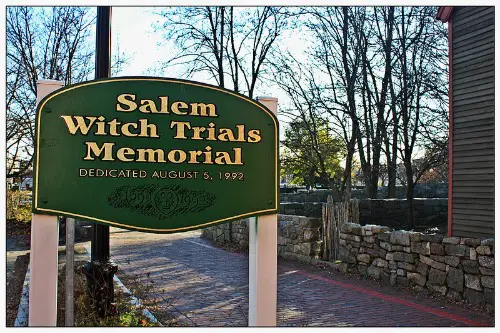
The Salem Witch Trials Memorial is a quiet yet haunting tribute to the 20 innocent men and women executed during the infamous witch trials of 1692. The trials began in a climate of fear and religious fervor, as accusations of witchcraft swept through the Puritan community of Salem. Those accused faced imprisonment, torture, and ultimately execution, often based on dubious evidence or personal vendettas. Most of the victims were women, marginalized by a society that viewed them with suspicion and as scapegoats for its anxieties. Their deaths highlight a dark period in American colonial history marked by mass hysteria and systemic injustice.
The memorial, consisting of stone benches inscribed with the names of the victims, serves as a sobering reminder of the dangers of unchecked fear and the consequences of societal paranoia. Visitors to Salem often come for its association with witchcraft, but the memorial encourages deeper reflection on the human cost of injustice. The Salem Witch Trials have become a cautionary tale, reminding us of the importance of due process, critical thinking, and resisting the urge to persecute others out of fear. The legacy of this tragedy continues to resonate in discussions about gender, power, and the fragility of justice.
2. Alcatraz Island, San Francisco Bay, California
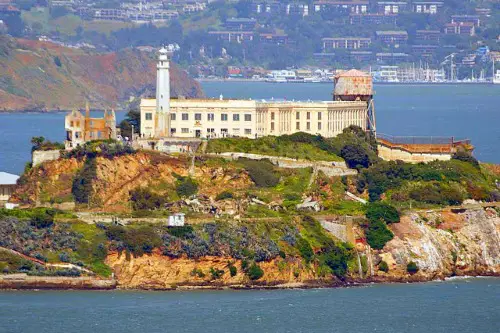
Alcatraz Island is best known as the site of a maximum-security federal prison that housed infamous criminals like Al Capone and “Birdman” Robert Stroud. However, the island’s history extends far beyond its years as a penitentiary and is steeped in painful chapters of oppression and resistance. Before the prison era, Alcatraz served as a military fort during the mid-19th century and later as a detention center for Native Americans who were forcibly removed from their lands. The island was used to isolate indigenous leaders and resistors, stripping them of their freedom and breaking their spirits. For Native Americans, Alcatraz represents a place of profound suffering and cultural erasure, emblematic of broader patterns of displacement and colonization.
In 1969, Alcatraz took on a new significance when it became the site of a 19-month-long occupation by Native American activists. These demonstrators sought to reclaim the island as a symbol of indigenous resilience and a protest against the federal government’s treatment of Native peoples. The occupation, though eventually ended by force, reignited national conversations about indigenous rights and sovereignty. Today, Alcatraz is a popular tourist attraction, but it also serves as a historical site that tells a complex story of injustice, resistance, and survival. Visitors are encouraged to reflect on both the infamous prison and the island’s role in the struggle for Native American recognition.
3. The Trans-Allegheny Lunatic Asylum, West Virginia
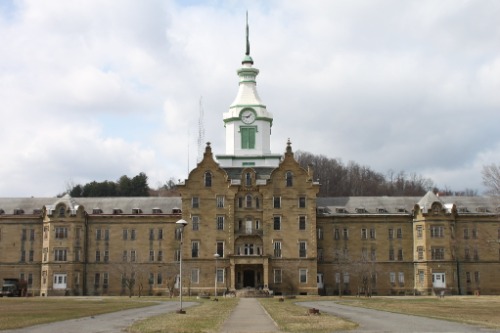
The Trans-Allegheny Lunatic Asylum is often regarded as one of the most haunted locations in America, but its chilling reputation is rooted in real-life horrors. Built in the mid-19th century to house individuals with mental illnesses, the asylum quickly became a symbol of the failings of the mental health care system. Designed to accommodate 250 patients, the facility at its peak held over 2,400 individuals, leading to severe overcrowding and deplorable conditions. Patients were subjected to inhumane treatments such as electroshock therapy, lobotomies, and prolonged isolation. Many entered the asylum with minor mental health concerns but left far worse—or never left at all.
Beyond its physical conditions, the asylum reflected a societal misunderstanding and fear of mental illness. Individuals were often committed for reasons that seem absurd today, such as “laziness” or “reading too many books.” Women, in particular, were frequently institutionalized for behavior deemed unbecoming or rebellious. Today, the Trans-Allegheny Lunatic Asylum is preserved as a historical site, offering ghost tours and educational programs that delve into its dark past. It serves as a stark reminder of the need for compassion and progress in mental health care and the dangers of allowing stigma to dictate treatment.
4. The White House, Washington D.C.
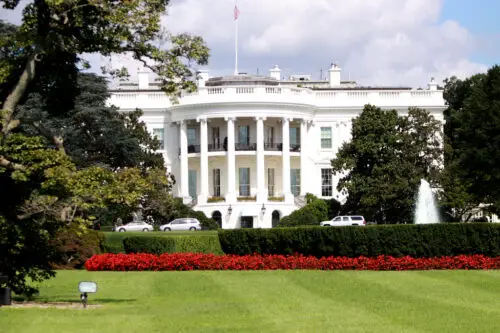
The White House is one of the most recognized symbols of American power and democracy, yet its history is rooted in exploitation. Construction of the building began in 1792, and much of the labor was carried out by enslaved African Americans, immigrants, and poor laborers under harsh conditions. These workers laid the foundation, cut the stone, and erected the walls of the mansion without receiving fair compensation—or any compensation at all in many cases. Enslaved individuals not only toiled on the building site but also provided the timber, quarried the stone, and carried out other essential tasks needed to complete the structure. Their forced labor highlights a deep contradiction at the heart of America’s founding ideals: a commitment to freedom built on the institution of slavery.
The White House now stands as a global symbol of freedom and democracy, but it also represents the nation’s struggle with its own hypocrisy and inequities. In recent years, efforts have been made to acknowledge the contributions of those enslaved workers through plaques, tours, and educational programs. However, this recognition does not undo the systemic injustice that marred the building’s creation. The story of the White House reminds us that even the most revered landmarks are not immune to the darker facets of history. By addressing these truths, the nation takes a step closer to reconciling its past and ensuring these stories are not forgotten.
5. Gettysburg National Cemetery, Pennsylvania
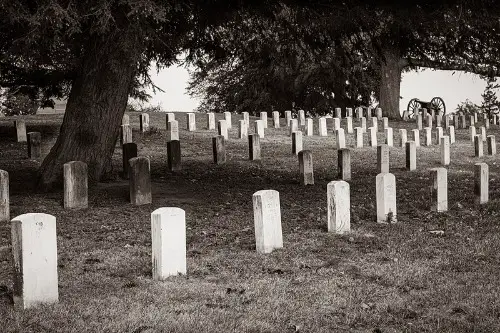
The Gettysburg National Cemetery is a solemn site that commemorates the sacrifices of thousands of soldiers who died during the Battle of Gettysburg, one of the bloodiest conflicts of the Civil War. Established in 1863, the cemetery is part of the larger Gettysburg battlefield, where Union and Confederate forces clashed in a fight that claimed over 50,000 lives. Rows upon rows of grave markers serve as a poignant reminder of the unimaginable loss of life and the devastating toll of the war. While the cemetery honors the bravery of those who fought, it also stands as a testament to the profound divisions that tore the nation apart.
The cemetery’s significance extends beyond its role as a burial site. It was here that President Abraham Lincoln delivered his iconic Gettysburg Address, a speech that underscored the principles of liberty and equality while acknowledging the immense cost of preserving the Union. However, the legacy of the Civil War, including its roots in slavery and systemic racism, continues to resonate today. Visiting Gettysburg invites reflection on the enduring consequences of conflict and the human capacity for both destruction and reconciliation. The cemetery is not just a place of remembrance but also a reminder of the work still needed to achieve unity and justice.
6. Slave Haven Underground Railroad Museum, Memphis, Tennessee
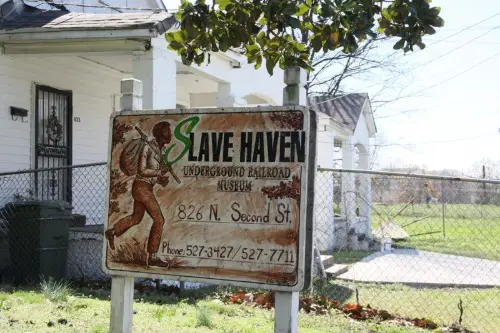
Located in a modest 19th-century home, the Slave Haven Underground Railroad Museum tells the story of brave individuals who risked everything to escape the horrors of slavery. The house, originally owned by Jacob Burkle, a German immigrant and abolitionist, served as a stop on the Underground Railroad, providing shelter and safety to enslaved African Americans seeking freedom. Beneath the house, a series of hidden tunnels and secret compartments were used to conceal fugitives from slave catchers. The museum offers a window into the harrowing experiences of those who fled enslavement, as well as the courage and compassion of those who helped them.
While the museum celebrates the bravery and resilience of those involved in the Underground Railroad, it also confronts visitors with the grim realities of slavery in America. Artifacts and exhibits detail the brutality of the slave trade, from the dehumanizing conditions of auction blocks to the constant threat of violence. Slave Haven is more than a historical site—it is a space for reflection on the enduring legacy of systemic racism and the ongoing struggle for equality. By preserving this history, the museum ensures that the stories of those who fought for freedom will never be forgotten.
7. The Manhattan Project National Historical Park, Los Alamos, New Mexico
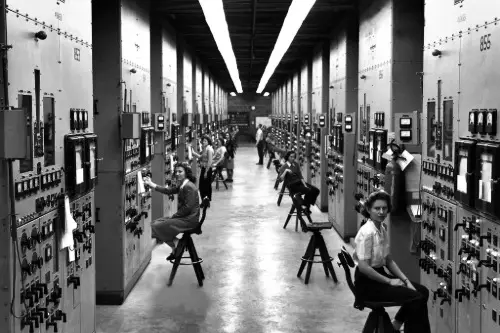
The Manhattan Project National Historical Park in Los Alamos, New Mexico, commemorates one of the most consequential and ethically fraught endeavors in American history: the development of the atomic bomb. During World War II, Los Alamos became the secret hub for scientists working on the Manhattan Project, a top-secret initiative to create nuclear weapons. Their efforts culminated in the bombs dropped on Hiroshima and Nagasaki in 1945, which led to Japan’s surrender but also caused unimaginable destruction and loss of life. The park preserves remnants of this pivotal project, including laboratories and living quarters, offering visitors a glimpse into the scientific and military efforts of the era.
While the Manhattan Project is often credited with ending World War II, it also raises profound moral questions about the cost of scientific advancement and the ethics of warfare. The use of nuclear weapons not only decimated two cities but also ushered in an era of global tension and the threat of nuclear annihilation. Today, the park serves as both a historical site and a space for reflection on the responsibilities that come with technological power. Visitors are reminded of the human cost of innovation and the importance of striving for peace in a world shaped by the legacy of nuclear weapons.
8. Mount Rushmore, South Dakota
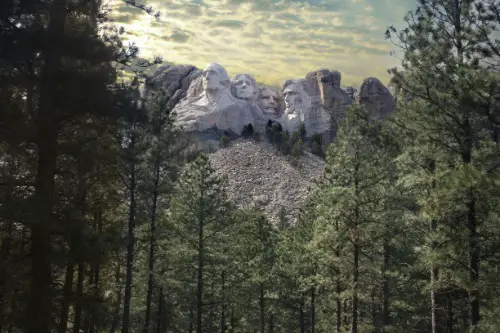
Mount Rushmore, with its colossal carvings of four U.S. presidents, is a marvel of engineering and artistry, but it is also a deeply controversial landmark. The monument was carved into the Black Hills, a region sacred to the Lakota Sioux and other Native American tribes. The U.S. government seized the land in the late 19th century, violating treaties and displacing indigenous communities. For Native Americans, Mount Rushmore is not a celebration of national pride but a symbol of colonization, cultural erasure, and broken promises. The very act of carving the faces of American leaders into sacred land is seen by many as an act of desecration.
The story of Mount Rushmore underscores the complex and often painful relationship between America’s history and its indigenous peoples. While millions of tourists visit the site each year, many are unaware of the land’s significance to Native communities or the struggles that continue to this day. Efforts to highlight the indigenous perspective, including nearby monuments like the Crazy Horse Memorial, aim to provide a more balanced narrative. Mount Rushmore stands as both a testament to human achievement and a reminder of the injustices that shaped the nation.
9. The Liberty Bell, Philadelphia, Pennsylvania
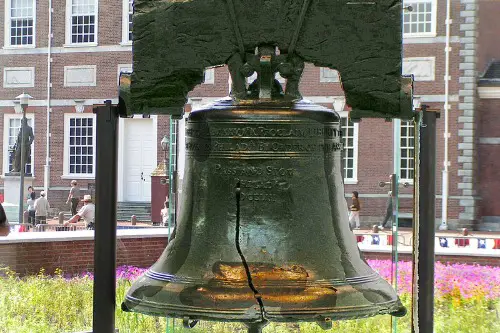
The Liberty Bell is one of America’s most enduring symbols of freedom and independence, yet its history is riddled with contradictions. Cast in 1752, the bell gained fame for its association with the signing of the Declaration of Independence. However, the ideals of liberty and equality it represents were far from universal at the time. Enslaved Africans, women, and indigenous peoples were excluded from the freedoms proclaimed by the founding fathers. The bell’s infamous crack, often romanticized as a symbol of imperfection, can also be seen as a metaphor for the fractured and unequal society it represents.
Today, the Liberty Bell is a popular tourist attraction, drawing visitors from around the world. Its significance has evolved over time, serving as a rallying point for abolitionists and later for civil rights activists. Yet the bell’s legacy is not without controversy. Some view it as a hollow symbol that glosses over the struggles of marginalized groups in America’s history. The Liberty Bell invites reflection on the gap between the nation’s ideals and its realities, reminding us that the pursuit of liberty is an ongoing struggle.
10. Centralia, Pennsylvania

Centralia, Pennsylvania, is a near-ghost town with a chilling story beneath its surface—literally. In 1962, a fire accidentally ignited in an underground coal seam beneath the town. Efforts to extinguish the blaze failed, and the fire spread uncontrollably, producing toxic gases and rendering the area unsafe for habitation. Over time, sinkholes opened, roads cracked, and homes became uninhabitable. The government declared the area condemned and began relocating residents. Today, fewer than five people remain in Centralia, living amid the eerie, smoking ruins of what was once a thriving coal-mining community.
The tragedy of Centralia serves as a stark warning about the environmental and human costs of industrial activities. The fire, which could continue burning for another century, highlights the long-term consequences of poor planning and regulatory oversight. Centralia’s story is also a testament to the resilience of its few remaining residents, who have chosen to stay despite the dangers. Visitors to the town are often struck by its desolate beauty, with abandoned streets and graffiti-covered pavement symbolizing both destruction and defiance. Centralia stands as a haunting reminder of the delicate balance between progress and preservation.
11. The Whaley House, San Diego, California
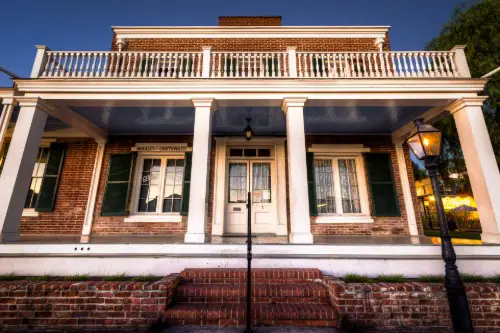
The Whaley House in San Diego is often billed as one of the most haunted houses in America, but its dark history goes far beyond ghost stories. Built in 1857 by Thomas Whaley, the house was constructed on land that had previously been the site of public executions. The most infamous hanging was that of “Yankee Jim” Robinson, who was convicted of theft and executed under controversial circumstances. The Whaley family themselves suffered multiple tragedies within the house, including the untimely deaths of children and a devastating suicide. These personal losses, combined with the site’s violent past, contribute to its unsettling reputation.
Today, the Whaley House is a museum, attracting visitors with its alleged paranormal activity and historical significance. Reports of unexplained sounds, sightings, and sensations have made it a popular destination for ghost hunters and history enthusiasts alike. Yet, the house also serves as a reminder of the fragility of life in early California and the often brutal nature of frontier justice. The stories tied to the Whaley House reflect not just the tragedies of one family but also the broader struggles of a young, developing nation.
12. The Pentagon, Arlington, Virginia
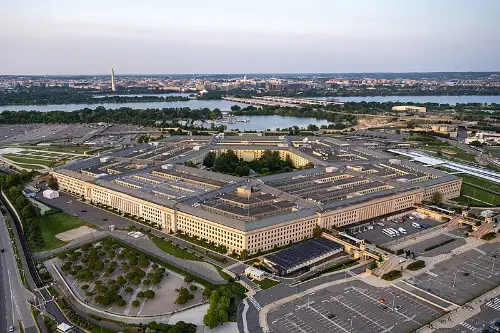
The Pentagon, the headquarters of the United States Department of Defense, is a symbol of military strength and strategy. However, its history was irrevocably altered on September 11, 2001, when it became a target of a terrorist attack. On that fateful day, American Airlines Flight 77 was hijacked and crashed into the western side of the Pentagon, killing 189 people, including passengers, crew, and Pentagon employees. The attack left a scar not only on the building but on the nation, symbolizing the vulnerability of even its most fortified structures. The events of 9/11 profoundly reshaped America’s sense of security and its approach to global conflicts.
The Pentagon’s history is also tied to the displacement of local communities during its construction in the early 1940s. The rapid development of the facility required the removal of residents and businesses in Arlington, Virginia, leaving some with a sense of loss that persists to this day. While the Pentagon stands as a testament to American resilience and military prowess, its story is one of sacrifice, both voluntary and involuntary. Visitors to the 9/11 Pentagon Memorial are reminded of the lives lost and the enduring impact of that tragic day.


